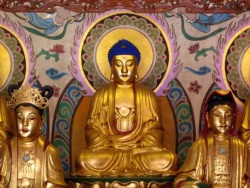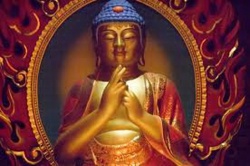Manual of Abhidharma - Reading Three: Types of Deeds, and the Nature of Motivation
69
Abbreviated List of Rights and Wrongs
A very gross abbreviation of them
All was stated as the ten paths of
Action, whether virtuous or not.
[IV.262-4]
A very gross abbreviation of all of them—of all right and wrong activities—was stated as the ten paths of action, whether we are talking about the ten virtuous types or the ten types which are not virtuous.
One may ask just what is not included in such an abbreviation. Certain steps of a particular act, say that of taking life, are not included. These would be the steps known as “undertaking” or “conclusion.” Neither have we included any but the most serious forms of action in speech; mental movement as an element in deeds of the thought has been omitted too.
As for virtues, the above abbreviation again leaves out the “undertaking” and “conclusion” steps for actions of the body. Examples of virtue in one’s speech, such as speaking sweetly, are omitted—as is mental movement in deeds of the thought.
Our more detailed treatment of what we call a “path of action” includes seven different parts:
1) the relative certainty of whether a given action includes types of form that either do or do not communicate one’s intentions;
2) the division of each of the paths of action into three different types;
3) the details of non-virtuous paths of action;
4) the ways in which one loses, and then regains, his most basic virtues;
5) how many paths of action can occur together with movement of the mind;
6) what paths of action are found in which realms, and among what types of beings; and
7) the results of the paths of action.
11
Virtue and the Other Types
…Freedom
Is the ultimate virtue. The roots as well as
Shame and a conscience are so in themselves.
Those that are linked with them, by a mental link;
Actions and the like, by motivation.
Their opposites, non-virtue. The ultimate
In the ethically neutral, those described.
[IV.30b-6]
One may ask whether virtue and the rest are established only on the basis of the motivation involved. They are not; in fact, there are four different divisions, beginning with what we call “ultimate” virtue. How do we describe them?
First consider freedom—nirvana. It is the ultimate virtue, for it is the highest state of happiness, free of every single suffering. It’s like a totally healthy person. Next consider the three roots of virtue, as well as a sense of shame and a conscience. They are virtue by nature, for they are virtue in and of themselves, without relying on anything else. They are like medicinal herbs.
Still further let us take those instances of mind and mental functions that are joined in a mental link with them—with these virtues. They are “mental-link” virtue, for we establish them as virtue by the fact that they share a mental link with virtue. They are, for example, like the liquid in which you mix your medicinal herbs.
Next consider physical and verbal actions and the like—the things that are motivated by the mental elements just described. They are what we call “motivational” virtue, for they are considered virtue by reason of the virtuous motivation involved with them. We can compare them to the milk that a mother produces after she has drunk the liquid mixed with the medicinal herbs described.
The opposites of each of the above are what we call “non-virtue”; the process is as follows. First take the cycle of life. It is the ultimate non-virtue, for it is the highest form of unhappiness—total bondage in suffering. It is like an illness.
Next consider the three root non-virtues, as well as shamelessness and the lack of a conscience. They are non-virtue by nature, for they are non-virtue in and of themselves, without relying on anything else. They are like poisonous herbs.
Then consider instances of mind and mental functions which share a mental link with these non-virtues. They are “mental-link” non-virtue, for we establish them as non-virtue because they share a mental link with non-virtue. These we can compare to a liquid in which the poisonous herbs were mixed.
Let’s next take the deeds of body and speech motivated by the mental elements described. These are “motivational” non-virtue, for we establish them as nonvirtue through the non-virtuous motivation involved. These types resemble the milk that a mother gives after she has drunk the liquid mixed with the poisonous herbs.
The ultimate in the things which are ethically neutral consist of those instances we have described previously: non-analytic cessations and unproduced space. We turn next to a description of motivation.
12
The Nature of Motivation
Two types of motivation: causal and
The one we give the name of “at the time.”
The first of the two acts to set you off;
The second’s function is to make you continue.
The consciousness eliminated by seeing
Is the one which starts. The thought for both
Eliminated by habituation.
The five function in continuation.
[IV.37-44]
One may begin as follows:
You have stated above that the communicating type of form can never be motivated by something which is eliminated by the path of seeing. Sutra though explains that mistaken views lead to mistaken thoughts, mistaken speech, and mistaken activity. Isn’t there a contradiction here?
There is not. In general, all motivation may be divided into two types: the motivation had during the causal stages of a deed and the one we give the name of “motivation at the time.” The first of the two acts to set you off: this is where you say before any particular action, “I’m going to do this or that.” The second’s function is to make you continue on: this is where you say to yourself after you’ve already started, “Now I’ll do this act.”
Now among these two, the consciousness eliminated by the path of seeing is the first, the one which starts you off on an action. This is the one that the sutra was referring to; when we made our statement, we were talking about how it couldn’t be the motivation during the time of the action.
The thought for both kinds of motivation includes types that are eliminated by the path of habituation, for it involves conceptions and is directed outwards. The five sense consciousnesses function only in continuation of a deed, for they are types of awareness that do not involve conception but which are directed outwards.
We continue now with certain relevant features of motivation.
13
Certain Features of Motivation
From starting types of virtue and the rest,
Come three types of continuation as well.
For the Able the same, or that one virtue.
Those that come from ripening are neither.
[IV.45-8]
One may ask whether it is assured that starting types of motivation that are virtuous or whatever will lead to continuing types of motivation that are also virtuous or such. From each of the starting types, from those of virtue and the rest, come all three types of continuation as well—whether it be virtue, non-virtue, or the ethically neutral.
For the Able Ones they are the same: starting types of motivation which have a virtuous nature lead to continuing types that are also virtue, and starting motivations of an ethically neutral character lead to continuing motivations that are neutral too. Or their starting motivations that are ethically neutral can lead to continuing motivations that are virtue. With the Able Ones though you can never have a continuing motivation which is ethically neutral coming from a starting motivation of virtue, for these beings’ motivation never digresses.
The Able Ones are never in any state of mind other than that of balanced meditation. They therefore possess no ethically neutral states of mind. For support we have the verse from sutra that says,
Even as he goes, the elephant meditates.
Even as he rises, the elephant meditates.
Even as he sleeps, the elephant meditates.
Even as he stays, the elephant meditates.
In reply to this assertion the Detailists make a claim of their own:
This is no proof that they can never have any state of mind that is not one of balanced meditation. The quotation is only referring to the way the Ones Thus Gone think as they act in any of the four different ways: when they are going somewhere, they conceive of themselves as going somewhere, and so on.
Those things that come about from a ripening of past deeds are neither the starting type of motivation or the continuing type. This is because their appearance does not rely on any particular application of effort—they just come out on their own.
This completes our discussion of the typical features of the three types of deeds in general. We move on now to the different divisions of non-communicating types of deeds, beginning with a brief summary and continuing to a more detailed treatment.
As for the first, non-communicating form can be understood as having three different types. These are vows, anti-vows, and those other than these two.
The Treasure House of Chim [Chim Jampey Yang's commentary to the Abhidharmakosha) states:
Sutra describes three kinds of karma: virtuous karma, non-virtuous karma, and neutral karma. Virtue is that karma which, in the short term, brings you a karmic ripening which is desirable (that is, a feeling of pleasure), and ultimately protects you from suffering (that is, helps you achieve nirvana). Non-virtue is that karma which brings you a karmic ripening which is undesirable (that is, a feeling of pain). A neutral deed, something neither virtuous nor non-virtuous, is that karma which brings you something which is neither desirable nor undesirable.
See also
- Manual of Abhidharma - Reading One: Introduction to Abhidharma
- Manual of Abhidharma - Reading Two: The Nature of Karma, and What it Produces; the Detailist Concept of ''Non-Communicating Form''
- Manual of Abhidharma - Reading Three: Types of Deeds, and the Nature of Motivation
- Manual of Abhidharma - Reading Four: The Correlation of Deeds and Their Results
- Manual of Abhidharma - Reading Five: How Karma is Carried, According to the Mind- Only School
- Manual of Abhidharma - Reading Six: How Emptiness Allows Karma to Work, According to the Middle-Way School
- Manual of Abhidharma - Reading Seven: Black and White Deeds, the “Path of Action,” and the Root and Branch Non-Virtues
- Manual of Abhidharma - Reading Eight: Most Basic Virtue, and the Projecting and Finishing Energy of Deeds
- Manual of Abhidharma - Reading Nine: The Five Immediate Misdeeds, and the Concept of a Schism
- Manual of Abhidharma - Reading Ten: The Relative Severity of Deeds and What Causes It
- Manual of Abhidharma - Additions Part 1
- Manual of Abhidharma - Additions Part 2



